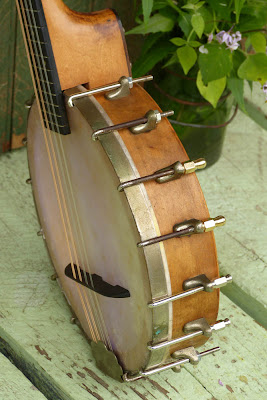c.1922 Weymann Style 35 Banjo Mandolin
I've worked on a few Weymann banjo-mandos, including some pretty fancy ones, but this plain-Jane style 35 retains all the rugged build and effective design elements of the more expensive stuff. The serial places it at 1922-ish and its 13 1/2" scale and big-slab ebony fretboard is familiar to me from working on their "Mandolute" line of regular mandolins.
Work included mounting a new skin head, scrounging a few replacement hooks (9 out of 16 of the hook/nuts on this guy are unoriginal and sort of hodge-podge), a fret level/dress, replacement bridge, cleaning, and setup. As expected, "she plays great," and has a sound I didn't expect right off the bat: warm and woody and sweet and not brutally-loud. It's more like playing a regular mandolin with some sort of effects pedal on than playing a "typical" banjo mandolin where one has to adjust his or her playing style a bit to get the most out of the instrument.
The smaller-than-normal 9 1/2" head gives this a very "ordinary mandolin" feel in the lap, as there's no big 11" rim making this feel oversized. The new skin head also looks great with its translucent look.
New bone nut (which I left unpolished to look right with the worn-in look of the instrument). The headstock veneer is "dyed something."
Nice pearl dots in a thicker ebony board. There's no worry about this fretboard extension dipping!
The very cool, vintage 3-foot ebony bridge came in an assortment of bridges sent to me as a gift by another repairman. I've been looking for a chance to use it and it fit perfectly on this fella. The width and spacing of the feet also make up for the use of a skin head on the instrument: even if the head "dips" a little with the weather the wider bridge means the action and tuning should remain stable.
I moved the assortment of original hook/nuts to the "playing" side of the instrument.
I lubed the recessed tuners and they work just fine.
You can definitely see the heavy-duty contruction on these guys: big multi-ply maple rim, good sturdy shim-based neck brace, and an additional stabilizer bar that's adjustable. Note the small area of top-layer rim delamination at the 10 o'clock position. It's only right at the "foot" of the rim and doesn't run up any farther than that.
Weymann label on the back of the headstock. The serial and style number are stamped into the top of the headstock.
...a couple of new rosewood shims for the neck brace...
To "tighten" this bar you actually turn "counter-clockwise" to pull it towards you: this then pulls the neck tighter to the pot and adds extra stability compared to many other brands. You could actually probably play this just fine without the additional (main) neck brace and its shims, but it's nice to have both!
The original tailpiece still has its cover! I muted the "extra string length" under the cover, too, to cut down on overtones.

















Comments